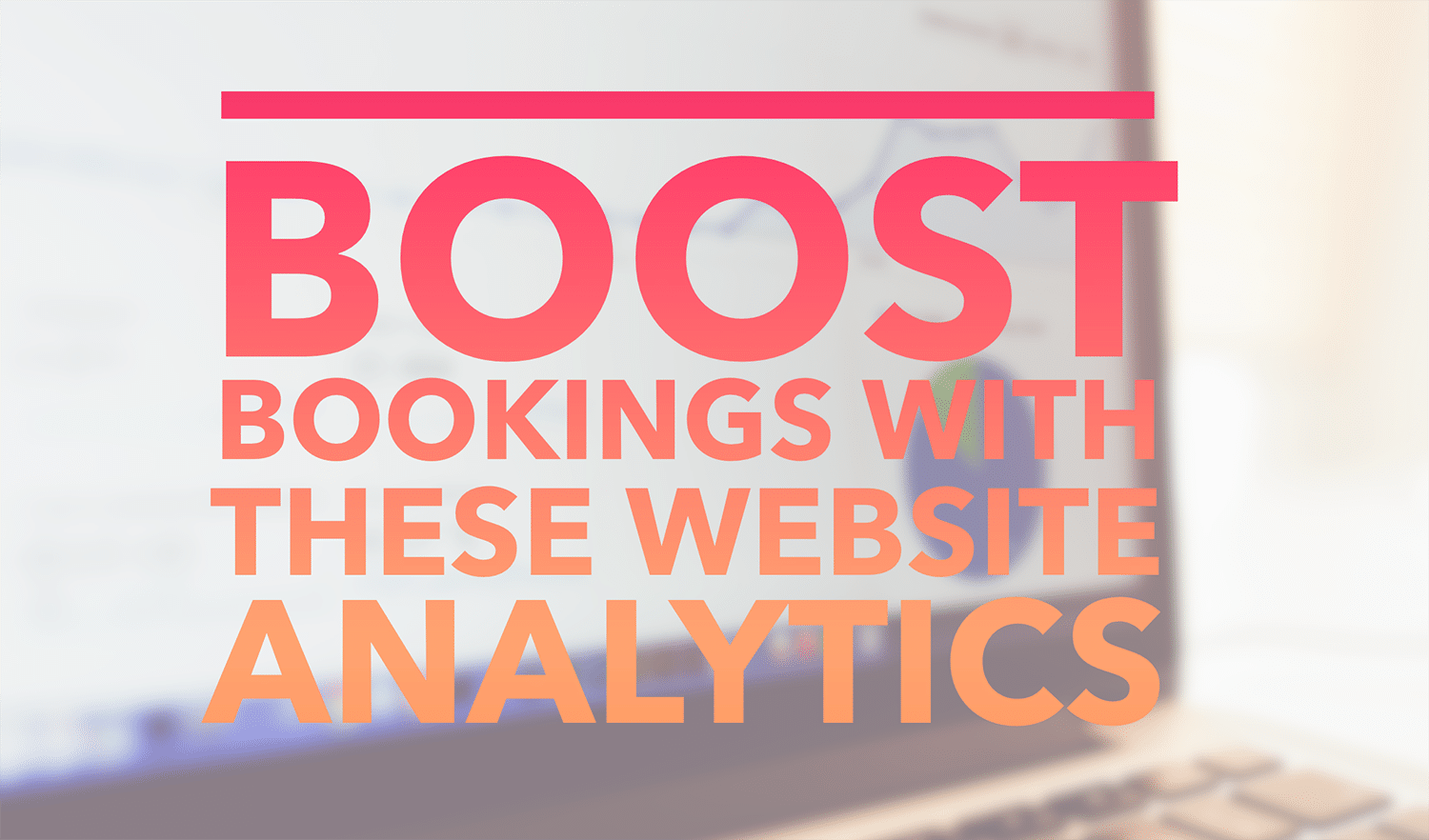
Your website is an important part of your business, especially when you use an online booking platform for your tours and activities. Knowing how it performs is a vital part of growing your business and your revenue, which is why Rezgo has implemented an analytics dashboard to help you get a better sense of where your bookings come from and how your website impacts your business.
But for a lot of small businesses and website owners, analytics don’t make much of a day-to-day difference. Sure, you might gather the data by adding your analytics and conversion codes to Rezgo. You might keep an eye on your dashboard to see how your website traffic ebbs and flows. But do you take the next steps and analyze that data? And with that analysis in hand, do you act?
If not, you’re hardly the only one. Most modern websites have analytics available, but fewer use them to their benefit. Taking that final step can give your company a serious advantage over the competition — but first, you need to prioritize.
The answers to these five questions will tell you where to spend your time and attention when planning website improvements.
Which pages drive your bookings?
When a customer books, they arrive on your site in two main ways:
Direct visits are those that arrive on your site by entering your URL directly into the browser. If those visits turn into bookings, it’s likely because those customers already knew what they wanted to book — either thanks to earlier research or through the assistance of one of your agents or staff members.
Organic visits are those that arrive on your site from another source, like a link on another website, or, more often, a search.
When you want to learn which pages are most effective at driving bookings, you need to look at the organic segment of your individual page reports. This will show you which pages are convincing customers to stay on your site and — if you’re looking at conversions — are helping them toward the decision to book.
Compare these reports for different pages on your booking website over set date ranges, and you’ll come to see which are most effective and which are least. It pays to know if one tour is regularly benefiting from searches that lead to another result entirely because then you can improve that tour’s page to better reflect what your customers are seeking. Pages that regularly lead to the most conversions should be analyzed with an eye to why they’re so effective, while poorly performing pages will need an overhaul.
You can safely ignore pages that shouldn’t influence conversions, like Terms & Conditions, unless those are seeing unusually high numbers for organic visits or conversions. If that’s the case, enjoy your good fortune and do what you can to guide those visits to more valuable pages.
Who are your website visitors?
Rezgo’s analytics can tell you a lot about your website visitors, and there’s more information to be had if you dig deeper.
If you use Google Analytics, you can enable Demographics and Interest Reports through the Analytics dashboard. It will take a few days before you start getting useful demographic data, but once you do, it can be astonishingly detailed.
Gender and age are the two main demographic categories Google offers. These will tell you a lot about where to spend your marketing dollars and focus. For instance, if your visitors are mostly young, Instagram and Snapchat will be worth more to you than Facebook. Visitors can also be tracked by combined age and gender if you need more detailed demographic information.
Affinity Categories let you go even deeper, sorting your visitors by broad interest categories. For example, Foodies may make up a large portion of your visitors’ interests, in which case you may want to look at food tour possibilities. On the other hand, foodies may be bouncing more often than other categories, in which case you may want to do more to capture their interest. Shoppers, Shutterbugs (ie, photography enthusiasts), Travel Buffs — these are all segments you may want to court or consider for your advertising and marketing plans.
Where do your big spenders come from?
When you track conversions through an analytics platform, you learn a lot not only about visitors in general — but also about the visitors who actually book.
What sort of information? Well, first, you can find out who they are. With demographics and interest reports, you can see which demographics and interests are generating the most revenue, allowing you to focus your ad dollars exactly where they’ll do the most good.
You can also learn where they come from. This is incredibly valuable information. If most of your conversions come from similar search terms, they can help shape plans for website adjustments. Armed with demographic and origination data, you can even tweak your inventory to better suit the customers who make bookings.
Alternately, there may be gaps in your keywords or general appeal that you want to address. Conversion data makes those decisions much easier because you’re acting on real customer data.
Finally, pay attention to any websites that regularly refer visitors who spend money. Those websites may deserve more or your personal attention.
How does mobile fare against desktop?
Smartphone users are a huge portion of the e-commerce market, so it’s absolutely vital to know how they interact with your website. Rezgo offers a responsive mobile template for all its users, so you can be sure that mobile customers enjoy the full booking experience without a hitch. If you aren’t using that template or you aren’t a Rezgo user, the first step is to ensure your site is fully accessible on mobile by visiting it and trying out the booking process.
The Rezgo dashboard allows you to see the portion of users that come from mobile sources. If you have mobile customers, you need to know how they’re using your site. One valuable way to do that is to look at bounce rates for your mobile segment.
Bounces are visits that end without any interaction. The visitor doesn’t continue to browse your site or complete a booking, they simply leave. Desktop bounce rates are also an important metric, but mobile is often more pressing. Mobile sites can be more challenging for both visitors and designers. You have to fit more information in less space, and visitors have to be able to navigate and find the information they’re looking for. Comparing a page’s mobile and desktop bounce rate can tell you a lot about whether the design of your mobile site is effective.

But how do you know if your bounce rate is any good? As usual, Google has the answer — this time, in the depths of its Analytics system. In Audience reports, the Benchmarking section includes industry-based benchmarking for devices, among several other categories. Here, you can see how your sessions and bounces compare to other websites in your industry, with about 1,600 industry categories to choose from.
If it turns out your bounces are well over the industry average, it’s time to consider whether changes to your mobile site’s design might be beneficial.
Is anyone acting on your Calls To Action?
Creating a compelling call to action (CTA) can be a big sales booster, but only if visitors end up acting on them. In the case of your website, that roughly translates to whether or not anyone’s clicking the Book Now or Sign Up Here buttons or links you create, or investigating promotions you put up.
In Google Analytics, the solution to CTAs is called event tracking. Event tracking requires more hands-on involvement with your website code than other types of tracking, so you may need assistance from a web developer.
Not only do event reports allow you to see whether your CTAs are being used, you can also see what pages are more effectively driving users to interact with them, and how they compare to each other. This gives you the information you need to redesign any underperforming CTAs — or to tune your high-performing CTAs to more effective offers or actions.
The sky’s the limit
The analytics available on the Rezgo dashboard can tell you a lot about your website’s users. With it, you can see popular regions and devices, inventory that attracts attention, the days that visitors like to shop, and more. From there, you may find you want to go deeper — and making use of the reporting tools Google and others offer will allow you to take an incredibly granular look at your visitors and their experiences with your website.
Armed with that data, there’s no limit to what you can do to boost your bookings, increase your revenue, and mindfully build your own success.





